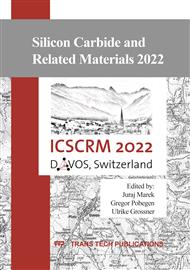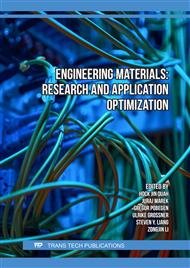[1]
N. Hatsopoulos, J. Donoghue. The Science of Neural Interface Systems. Annual review of neuroscience. 32 (2009) 249-66.
Google Scholar
[2]
N. H. Lovell, J. W. Morley, S. C. Chen, L. E. Hallum and G. J. Suaning, Biological–Machine Systems Integration: Engineering the Neural Interface. Proceedings of the IEEE, vol. 98 (2010) 3, 418-431.
DOI: 10.1109/jproc.2009.2039030
Google Scholar
[3]
C.H. Chiang, S.M. Won, A.L. Orsborn, K.J. Yu, M. Trumpis, G. Bent, C. Wang, Y. Xue, S. Min, V. Woods, C. Yu, B.H. Kim, S.B. Kim, R. Huq, J. Li, K.J. Seo, F. Vitale, A. Richardson, H. Fang, Y. Huang, K. Shepard, B. Pesaran, J.A. Rogers, J. Viventi. Development of a neural interface for high-definition, long-term recording in rodents and nonhuman primates. Sci Transl Med. 2020 Apr 8;12(538):eaay4682. doi: 10.1126/scitranslmed.aay4682. PMID: 32269166; PMCID: PMC7478122.
DOI: 10.1126/scitranslmed.aay4682
Google Scholar
[4]
J.M. Hsu, L. Rieth, R.A. Normann, P. Tathireddy, F. Solzbacher. Encapsulation of an integrated neural interface device with Parylene C. IEEE Trans Biomed Eng. 2009 Jan;56(1):23-9. doi: 10.1109/TBME.2008.2002155. PMID: 19224715.
DOI: 10.1109/tbme.2008.2002155
Google Scholar
[5]
F. Deku, Y. Cohen, A. Joshi-Imre, A. Kanneganti, T.J. Gardner, S.F. Cogan. Amorphous silicon carbide ultramicroelectrode arrays for neural stimulation and recording. J Neural Eng. (2018) Feb; 15(1):016007.
DOI: 10.1088/1741-2552/aa8f8b
Google Scholar
[6]
C. Feng & C. Frewin & M. R. Tanjil & R. Everly & J. Bieber & A. Kumar & M.C. Wang & S.E. Saddow. A Flexible a-SiC-Based Neural Interface Utilizing Pyrolyzed-Photoresist Film (C) Active Sites. Micromachines. 12. (2021).
DOI: 10.3390/mi12070821
Google Scholar
[7]
M.Avram, A.Avram, A. Bragaru, B.Chen, D. Poenar, C. Iliescu. Low stress PECVD amorphous silicon carbide for MEMS applications. Semic. Conf. CAS 2010 Int. (2010). 01. 239-242.
DOI: 10.1109/smicnd.2010.5650647
Google Scholar
[8]
S. Kwon, Y. Park, W. Ban, C. Youn, S. Lee, J. Yang, D. Jung, T. Choi. Effect of plasma power on properties of hydrogenated amorphous silicon carbide hardmask films deposited by PECVD. Vacuum (2020) Apr;174.
DOI: 10.1016/j.vacuum.2020.109187
Google Scholar
[9]
Y. Inoue, S. Nakashima, A. Mitsuishi, S. Tabata, S. Tsuboi. "Raman spectra of amorphous SiC." Solid State Communications 48 (1983): 1071-1075.
DOI: 10.1016/0038-1098(83)90834-7
Google Scholar
[10]
J.M. Hsu, P. Tathireddy, L. Rieth, A.R. Normann, F. Solzbacher. Characterization of a-SiC(x):H thin films as an encapsulation material for integrated silicon based neural interface devices. Thin Solid Films. (2007) Nov 1;516(1):34-41.
DOI: 10.1016/j.tsf.2007.04.050
Google Scholar
[11]
Diaz-Botia. "Silicon carbide technologies for interfacing with the nervous system" PhD thesis, University of California, Berkeley. (2017).
Google Scholar
[12]
Y. Inoue, S. Nakashima, A. Mitsuishi, S. Tabata, S. Tsuboi, Raman spectra of amorphous SiC, Solid State Communications, Volume 48, Issue 12, 1983, Pages 1071-1075, ISSN 0038-1098.
DOI: 10.1016/0038-1098(83)90834-7
Google Scholar
[13]
H. Wieder, M. Cardona, C.R. Guarnieri. Vibrational Spectrum of Hydrogenated Amorphous Si-C Films. Phys. Stat. Sol. (b) (1979) 92, 99
DOI: 10.1002/pssb.2220920112
Google Scholar
[14]
W. Daves, A. Krauß, N. Behnel, V. Häublein, A. Bauer, L. Frey. Amorphous silicon carbide thin films (a-SiC:H) deposited by plasma-enhanced chemical vapor deposition as protective coatings for harsh environment applications. Thin Solid Films. 519. (2011). 5892-5898.
DOI: 10.1016/j.tsf.2011.02.089
Google Scholar
[15]
S. King, J. Bielefeld, G. Xu, W. Lanford, Y. Matsuda, R. Dauskardt, N. Kim, D. Hondongwa, L. Olasov, B. Daly, G. Stan, M. Liu, D. Dutta, D. Gidley. Influence of network bond percolation on the thermal, mechanical, electrical and optical properties of high and low-k a-SiC:H thin films. Journal of Non-Crystalline Solids. 379. (2013). 67.
DOI: 10.1016/j.jnoncrysol.2013.07.028
Google Scholar
[16]
F. Deku, S. Mohammed, A. Joshi-Imre, J. Maeng, V. Danda, T.J. Gardner, S.F. Cogan. Effect of oxidation on intrinsic residual stress in amorphous silicon carbide films. J Biomed Mater Res B Part B. (2018). 2018:9999:9999:1–8.
DOI: 10.1002/jbm.b.34258
Google Scholar
[17]
Stefan Janz, "Amorphous Silicon Carbide for Photovoltaic Applications", PhD Dissertation Un.Konstanz Germany, (2006)
Google Scholar



